Intel's Pentium M on the Desktop - A Viable Alternative?
by Anand Lal Shimpi on February 7, 2005 4:00 PM EST- Posted in
- CPUs
Multitasking Content Creation
MCC Winstone 2004
Multimedia Content Creation Winstone 2004 tests the following applications in various usage scenarios:- Adobe® Photoshop® 7.0.1
- Adobe® Premiere® 6.50
- Macromedia® Director MX 9.0
- Macromedia® Dreamweaver MX 6.1
- Microsoft® Windows MediaTM Encoder 9 Version 9.00.00.2980
- NewTek's LightWave® 3D 7.5b
- SteinbergTM WaveLabTM 4.0f
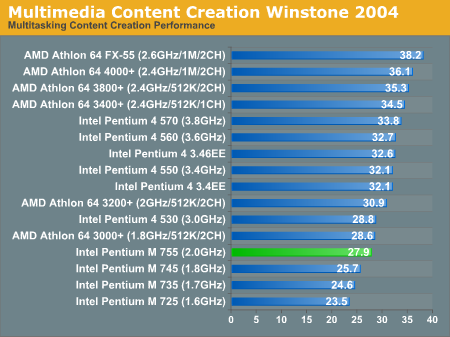
The more memory bandwidth and FP intensive MCC applications give the Pentium M a hard time, as it falls to the bottom of the performance charts.
ICC SYSMark 2004
The first category that we will deal with is 3D Content Creation. The tests that make up this benchmark are described below:"The user renders a 3D model to a bitmap using 3ds max 5.1, while preparing web pages in Dreamweaver MX. Then the user renders a 3D animation in a vector graphics format."
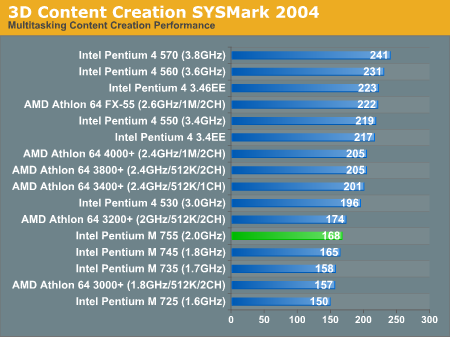
The Pentium M continues to perform dismally in content creation applications.
Next, we have 2D Content Creation performance:
"The user uses Premiere 6.5 to create a movie from several raw input movie cuts and sound cuts and starts exporting it. While waiting on this operation, the user imports the rendered image into Photoshop 7.01, modifies it and saves the results. Once the movie is assembled, the user edits it and creates special effects using After Effects 5.5."
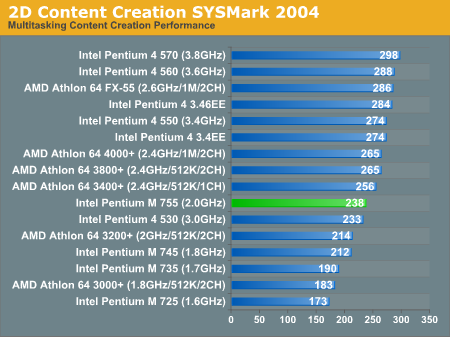
Things are a little better in the 2D content creation world, with the Pentium M performing on the lower end of the middle of the pack.
The Internet Content Creation suite is rounded up with a Web Publishing performance test:
"The user extracts content from an archive using WinZip 8.1. Meanwhile, he uses Flash MX to open the exported 3D vector graphics file. He modifies it by including other pictures and optimizes it for faster animation. The final movie with the special effects is then compressed using Windows Media Encoder 9 series in a format that can be broadcast over broadband Internet. The web site is given the final touches in Dreamweaver MX and the system is scanned by VirusScan 7.0."
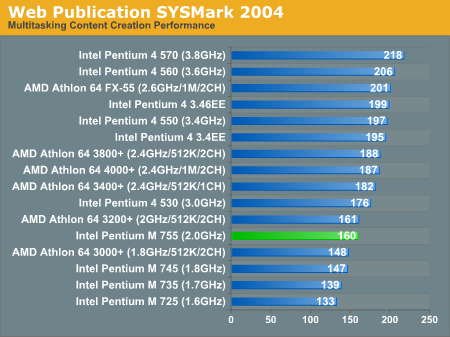
Once again, we have another situation where the Pentium M can't cut it on the desktop compared to its faster counterparts.
Mozilla + Media Encoder
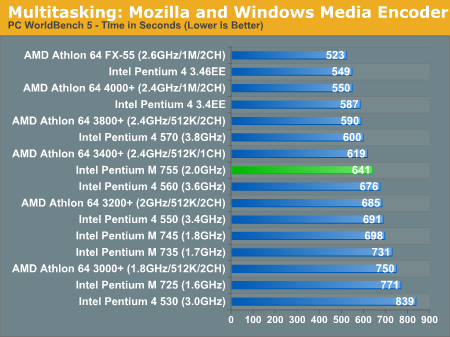
The Pentium M isn't very strong in media encoding applications, and thus, we don't see such solid performance here, thanks to its relatively weak FPU.










77 Comments
View All Comments
fitten - Tuesday, February 8, 2005 - link
Also, it's interesting that there are many benchmarks chosen which are known to stress the weaknesses of the Pentium-M... not that it isn't interesting information. For example, there seems to be a whole lot of FPU intensive benchmarks (around 15 or so, all of which the Pentium-M should lose handily - known before they are even run) so kind of just hammering the point home I guess.Anyway, the Dothans held up pretty well from what I can see... Most of the time (except for the notable FPU intensive and memory bandwidth intensive benchmarks), the Dothan compares quite well with Athlon64s of the same clock speed that have the advantage of dual channel memory.
fitten - Tuesday, February 8, 2005 - link
The other interesting thing about the Athlon64 vs. Dothan comparison is that even with dual channel memory bandwidth on the Athlon64's side, the single channel memory bandwidth of the Dothan still keeps it very close in many of the benchmarks and can even beat the dual channel Athlon64s at 400MHz higher clock in some.Anyway, the Pentium-M family is a good start. Some tweaking here and there (improved FPU with better FPU performance and maybe another FPU execution unit, improved memory subsystem to make good use of dual channel) and it will be at least as good as the Athlon64s across the board.
I own three Athlon64 desktops, two AthlonXP desktops, and two Pentium-M laptops and the laptops are by no means "slow" at doing work.
KristopherKubicki - Tuesday, February 8, 2005 - link
teutonicknight: We purposely don't change our test platform too often. Even though we are using a slightly older version of Premiere, it is the same version we have used in our other processor analyses.Hope that helps,
Kristopher
kmmatney - Tuesday, February 8, 2005 - link
There's also a Celeron version that would have been intersting to review. The small L2 cache should hurt the performance, though. I think the celeron version using something like 7 Watts. It would make no sense to put a celeron-M in such an expensive motherboard, though.Slaimus - Tuesday, February 8, 2005 - link
I think this indirectly shows how AMD needs to update its caching architecture on the K8. They basically carried over the K7 caches, which is just too slow when paired with its memory controller. Instead of being as large as possible (as evidenced by the exclusive caches) at the expense of latency, the K8 needs faster caches. The memory bandwith of L2 vs system memory is only about 2 to 1 on the K8, which is to say the L2 cache is not helping the system memory much.sandorski - Monday, February 7, 2005 - link
I think the Pentium M mythos can now be laid to rest.mjz5 - Monday, February 7, 2005 - link
to #29:your 2800 is the 754 pin.
the 3000+ reviewed is the 939 pin which is 1.8. the 3000+ for the 754 is 2.0 ghz
kristof007 - Monday, February 7, 2005 - link
I don't know if anyone else noticed but the charts are a bit off. My A64 2800+ is running at a stock 1.8 ghz .. while in the review the A64 3000+ is running at 1.8 ... weird!knitecrow - Monday, February 7, 2005 - link
#251) Intel and AMD measure TDP differently... and TDP is not the same as actual power dissipation. The actual dissipation of 90nm A64 is pretty darn good.
2) A microprocessor is not made of Lego... you can't rearrange/tweak parts to make it faster. It takes a lot of time, energy and talent to make changes -- even then it may not work for the best. Prescott anyone?
Frankly I’ve been waiting for a good review of P-M's actual performance. I really don't trust those "other" sites.
k00kie - Monday, February 7, 2005 - link